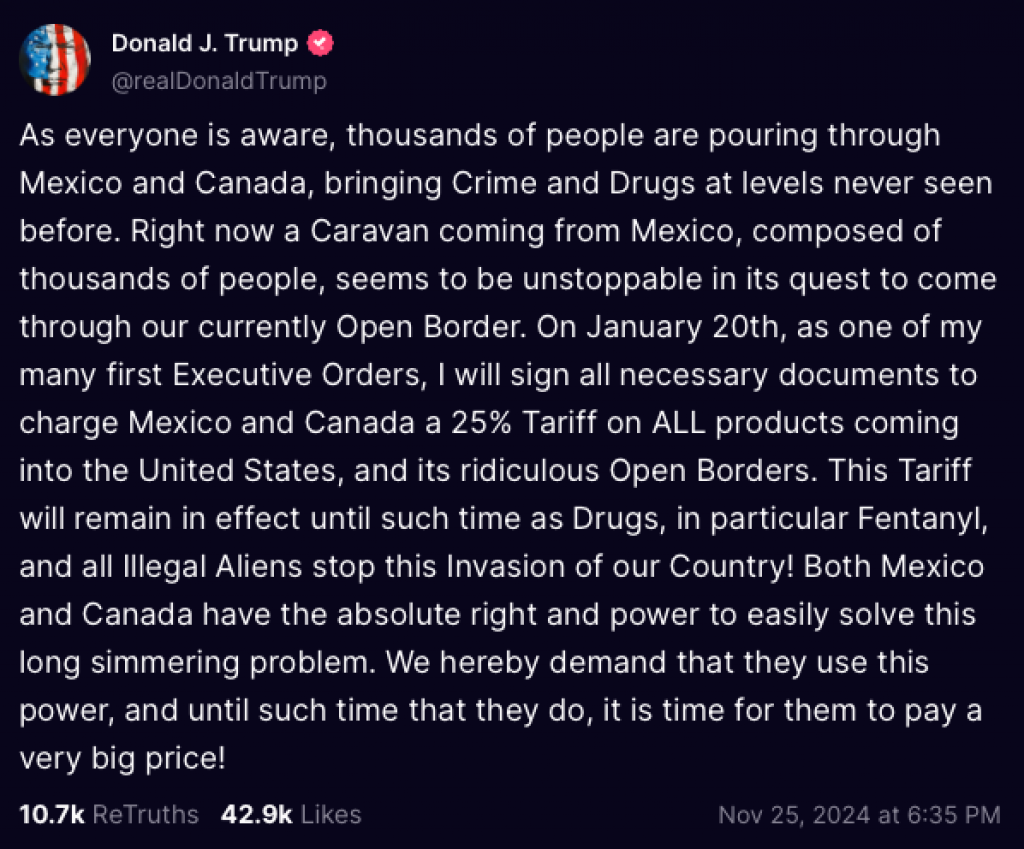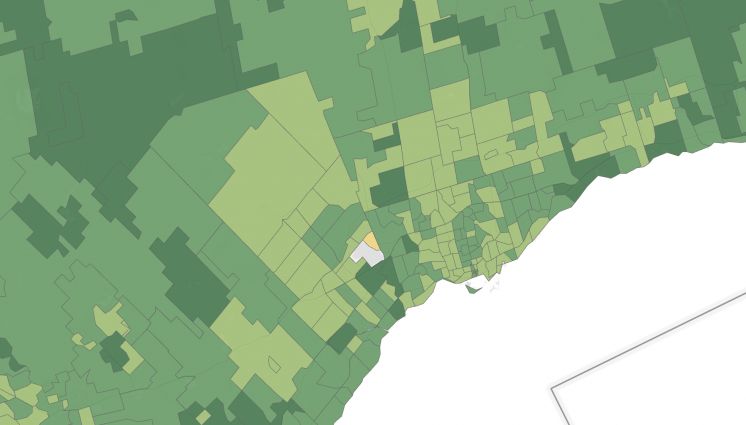Late Monday night, U.S. President-elect Donald Trump used his Truth Social platform to announce he would impose across-the-board 25 per cent tariffs on Canada and Mexico on day one of his new administration. Trump said he would leave the tariffs in place “until such time as Drugs, in particular Fentanyl, and all Illegal Aliens stop this Invasion of our Country! (sic)”

Deputy Prime Minister Freeland’s first response was to say Canada “places the highest priority on border security and the integrity of our shared border,” adding that two-way trade with the United States is balanced and mutually beneficial. This was basically how China’s U.S. embassy responded to Trump’s threat to impose an additional 10 per cent tariff on all Chinese imports, which was also related to the fentanyl trade.
Canadian business groups and some provincial premiers, including B.C. Premier David Eby, joined the discussion shortly after with concerns about how the tariffs would affect Canadian businesses and jobs. “Canadians must stand united. Ottawa must respond with strength. We’ll never stop fighting for British Columbian families,” Eby said. Ontario Premier Doug Ford said tariffs would be “devastating” and called for a Team Canada solution “now.”
To state the obvious, a 25 per cent across-the-board tariff on all Canadian and Mexican exports to the U.S. would be highly disruptive for both countries. The tariffs make a mockery of the Canada-U.S.-Mexico Agreement (CUSMA—the new NAFTA) and more or less blow up the longstanding assumption of stable, negotiated access to the U.S. market.
Even if Trump does not follow through on his tariff threat, or if he does and they are short-lived, the shock will be enough to convince some Canadian firms to jump the border or invest in U.S. rather than domestic manufacturing. Over the longer term, tariffs will depress Canadian growth and put a significant number of Canadian jobs at risk.
As bad as this all sounds, we cannot let these legitimate but so far speculative fears lead to a panicked response on borders, migration or drug policy—which is what Trump appears to be aiming for with the announcement. Human lives are at stake. Trump justified his 10 per cent tariff on Chinese imports by saying that “unfortunately” China has not followed up on a promise to use the death penalty for convicted fentanyl drug traffickers.
It’s important to grasp that Trump is not proposing these tariffs to correct a perceived harm to the U.S. economy. All of Canada’s talking points to date—including throwing Mexico under the bus for not following the U.S. and Canada with a 100 per cent tariff on Chinese electric vehicles—have assumed that this is where the Trump administration would go.
The proposed 25 per cent tariff is economic action to coerce trading partners into alignment on drug policy and migration. The Canadian and Mexican governments may have no choice now but to negotiate a border arrangement with Trump, but we should be clear about the legal red lines we will not cross.
Legal basis of Trump’s tariffs
The first Trump presidency justified 25 and 10 per cent tariffs on Canadian steel and aluminum imports, respectively, under national security provisions in Section 232 of the Trade Expansion Act. This law allows the president to impose tariffs on imports of certain goods if an investigation determines those imports threaten the security interests of the United States.
It is very unlikely that this route would or could be used to impose blanket tariffs on all Canadian and Mexican goods. For that, Trump is likely to use the broad and largely untested authority within the International Emergency Economic Powers Act (IEEPA), which allows the president to regulate international financial transactions, including through sanctions, in response to a declared national emergency.
Trump declared the opioid crisis a national emergency in 2017 to justify completing a border wall along the full Mexico–U.S. border and accessing funds for a law-and-order based approach to the crisis. This was at the same time that his administration was trying to de-fund enhancements to the U.S. health system.
In 1971, President Richard Nixon used the IEEPA to impose a blanket 10 per cent tariff on all U.S. imports to avoid a balance-of-payments crisis following the U.S. move to sever the U.S. dollar from the price of gold. The tariffs were challenged but the courts upheld Nixon’s authority to enact them.
There is no definition of a national emergency in the IEEPA and its scope is very broad. Robert Lighthizer, Trump’s former and possibly upcoming United States Trade Representative, supports using the IEEPA to decouple China-U.S. trade and investment links. Applying it to Canada and Mexico may provide a test case for future use elsewhere.
Market access and borders
There is nothing surprising about Trump’s proposed tariffs when we consider the past 20 years of Canada-U.S. border security cooperation. Trump knows that when U.S. market access is threatened, Canadian businesses and politicians agitate for alignment at any cost.
For example, commenting on a traveller information sharing proposal under both the George W. Bush and Obama administrations that raised privacy concerns in Canada, the Canadian Manufacturers and Exporters told the Hill Times:
“The idea of sharing data does not scare us from an industry association perspective…We’re concerned more about flow of people and goods across the border, and if this can help facilitate the flow of individuals for work purposes or for personal reasons then it’s a good thing.”
Previous grand bargains for North American economic and security cooperation like the Harper government’s Beyond the Border initiative with Obama or the earlier Security and Prosperity Partnership have produced substantial alignment with the U.S. on its national security and anti-terrorism priorities, including cooperation on controversial U.S. rendition practices.
None of this cooperation has made the Canadian economy any less vulnerable to trade threats or policy shifts in the U.S. That fact should temper calls in Canada to concede to Trump’s demands—whatever they are—quickly. Alberta Premier Danielle Smith has said Trump’s concerns about illegal actions at the border are legitimate but she seems more concerned about oil revenues.
The Canadian and Mexican challenge
Many Canadians may be puzzled why Trump put Mexico and Canada in the same category of risk to the U.S. with respect to drugs and migration.
Canada has gone from importer to a significant producer and trafficker in fentanyl. The shift reportedly occurred following China’s crackdown on fentanyl exports in response to pressure from Trump’s first administration. China is still a source of precursor chemicals in fentanyl production. But those chemicals are being imported into Canada, the U.S. and Mexico, in part thanks to loopholes in so-called de minimis tariff exemptions on small e-commerce purchases from China.
Often the criminal networks facilitating this trade are the same in Mexico as in Canada. Canadian premiers calling Mexico the bad apple and demanding a unique Canada-U.S. trade deal should be embarrassed. Migration is obviously a larger issue for Mexico than Canada, but Canadian decision-makers have no moral leg to stand on in trying to deflect attention from the northern to the southern border.
It’s possible threats of massive retaliation from Mexico and Canada, along with domestic pressure on the president-elect, will change Trump’s mind before January 20. Unfortunately, that seems unlikely given Trump’s desire to flex his executive trade powers and his desire to move quickly on migration.
The significant challenge for Canada may be to negotiate an arrangement with Trump on the fentanyl trade that does not cave in to the Republicans’ failed law-and-order approach to tackling the opioid crisis or compromise human rights or Canadian law. Human lives are on the line—in particular those in vulnerable migrant communities.
The Trudeau government will also need to prepare for the 25 per cent tariffs should those border negotiations fail or drag out. This could include targeted retaliatory measures (tariffs) on Trump-allied interests in the U.S. and preparing a furloughing plan for workers affected by potential layoffs. The priority should be on people, not profits.
A 25 per cent tariff on Canadian exports to the U.S. would be extremely difficult to bear given the extent of Canada-U.S. trade. But there are limits to what Canada can agree to in order to make those tariffs go away, despite the Canadian business lobby’s willingness to appease any and all U.S. security demands.
In the longer term, Canada needs to become less vulnerable to shocks in the U.S. There can be no more illusions about Canadian businesses maintaining perpetual priority access to the U.S. market. Trump has driven a spike through North American trade with this tariff threat. We need a plan B.







